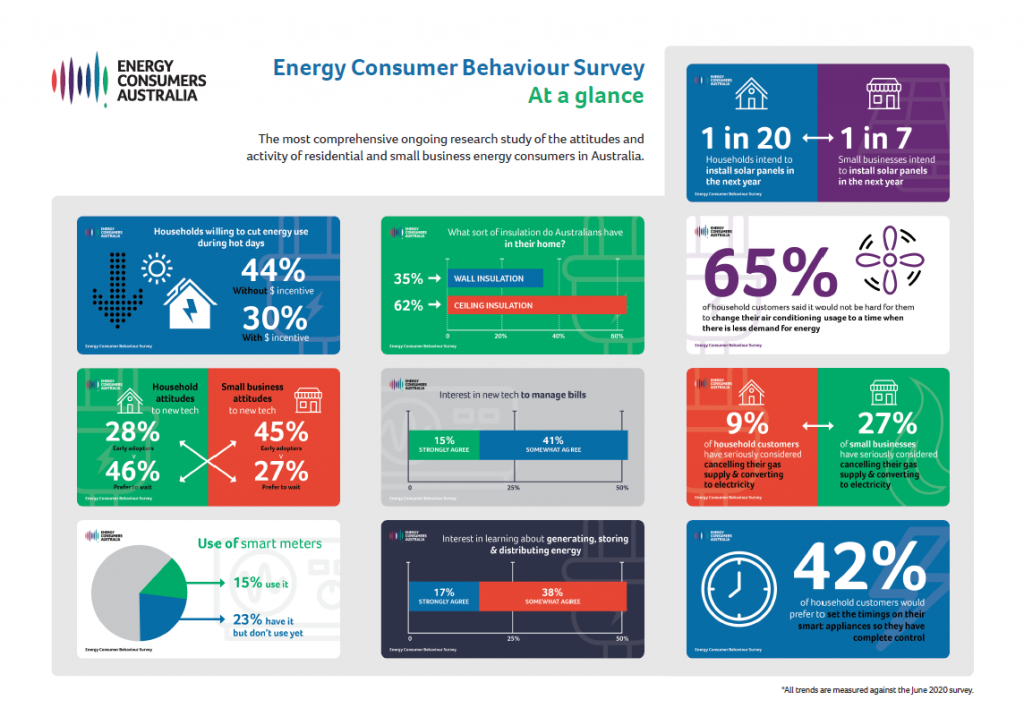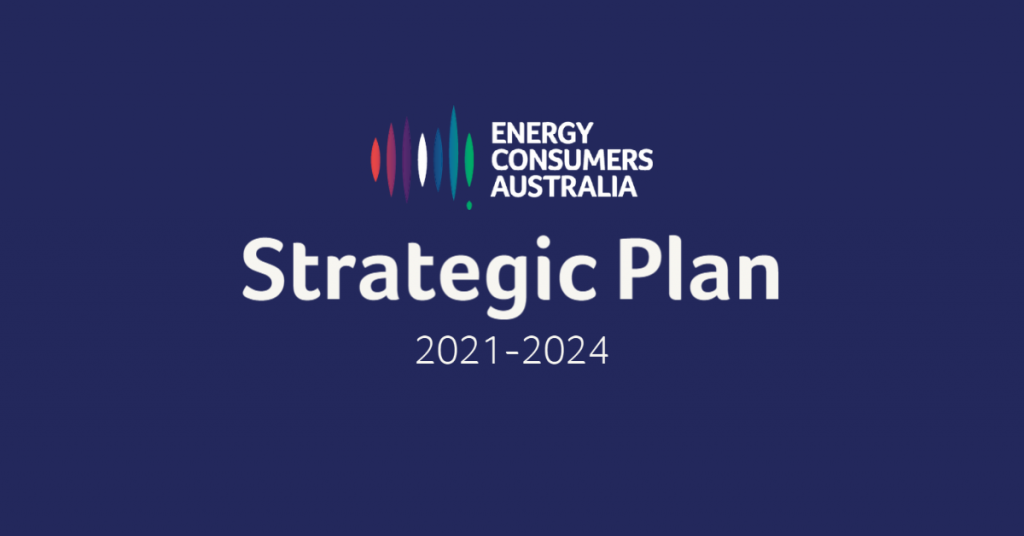If you would like to subscribe to the Energy Consumers Australia mailing list please click here.
From the CEO
Dear Readers,
Even though I enjoyed two weeks holidays during October, (mostly spent catching up on much needed sleep, reading and Netflix!), things remained as busy as ever for all of us at Energy Consumers Australia. I even managed to fit an appearance at The Economist's Future of Energy Week during my down time, to discuss the role of consumers in Asia’s energy transition.
Much like my submission to the KPMG 30 Voices on 2030 (pg 57-59), my take is that consumers have already upended the energy system and brought about a second transition, driven by their expectations of a better energy future. 69% of the KPMG ‘Voices’ agreed that most businesses and households in Australia will have shifted to use of solar and battery storage in 2030. I think there is a strong possibility that that day could come sooner than anticipated. The adoption of technologies in homes and businesses in this country is already moving faster than the industry mindset for change. Almost 3 million households across Australia have fitted their rooftops with solar panels, together creating the largest electricity generator in the country, producing clean and virtually free energy every day that is often going to waste.
Action in the face of climate change
As the world looks to the Conference of Parties (COP26), and Australia’s new plan for achieving net-zero emissions by 2050, it has never been clearer that the time for action is now. We are standing at a key inflection point as we push towards a future system that can run with 100% renewable energy. That change is coming and is now irreversible. But the decisions we make in the coming period will go a long way to deciding whether the transition delivers what consumers consistently tell us they expect: clean and affordable energy that is there for them when they need it.
Australia has adopted a motto of “technology not taxes” during its appearances in Glasgow. The stated intention has been to deliver a transition to clean energy (and hence lower emissions) without dealing a financial disadvantage to everyday Australians. In this context it’s worth noting that such disadvantage could come in multiple forms. Greater-than-necessary investment in some of those technologies (and in scaling them) is not without substantial cost. When it comes to the energy system, we know that some investment will be required to handle the larger amounts of renewables flooding onto the future grid. But spending more than we need to on new generation, transmission and distribution infrastructure will deliver a financial impost every bit as real as new taxes: increased energy costs for Australian households and businesses as the cost of investment is transferred back to them.
That is why we are adamant the time is now to focus on using our existing infrastructure and resources smarter and more efficiently – in ways that secure the cooperation of consumers for their own benefit and the planet’s, rather than impose unwanted change upon them.
This means that all of us who seek to influence, plan, operate and regulate the energy system need to get far more serious about maximising the opportunities offered by demand flexibility, by co-ordinating how Distributed Energy Resource (DER) operate and other key ways of unlocking existing resources such as pushing hard towards more energy efficient housing, old and new. We need to see these challenges as central to the net zero task, not as peripheral “nice to have” elements of a planning agenda dominated by infrastructure investment. Much of our work currently underway and planned for the future focuses on this challenge.
A mindset for change
Prioritising such measures requires a mindset change, elevating them to the “grown-ups table” and investing them with the seriousness they deserve. For this to succeed, consumer participation and the decisions Australians will be required to make about when and how they support the grid (while living their lives) should be recognised, planned for, rewarded and integrated. By updating market design and regulation to support the system that consumers are already building, we can avoid crippling future generations with a return to historically-high electricity bills. We are motivated to make sure these considerations continue to rise up the agenda as the sector gets on with some major pieces of work in planning for the future and executing those plans.
On this, I was pleased to see Australian Energy Market Commission (AEMC) Chair Anna Collyer, appointed to the position of Energy Security Board (ESB) Chair as the Post-2025 energy market package received the go ahead from the National Cabinet this week. We need strong leaders to drive necessary system change and I look forward to working with Anna, Australian Energy Market Operator (AEMO) CEO and Managing Director, Daniel Westerman, and Australian Energy Regulator (AER) Chair, Clare Savage to ensure the values, expectations and needs of energy consumers are met through the reforms. We are thankful to the outgoing Dr Kerry Schott and David Swift for their tireless work on these challenges and for their willingness to engage constructively with myself and the Energy Consumers Australia team on behalf of consumer interests.
Every household and small business in this country has its own unique profile of how it uses energy, and what is important to them in terms of how they’re using the energy. We also must remember, not everyone is able to install solar or batteries, invest in an electric vehicle, study their smart meter readings… nor might they want to. Therefore, planning and implementing a human-centred design that delivers significant customer and system benefits and negligible impacts requires ongoing research, large-scale innovation, and a multidisciplinary approach. None of this is possible if you don’t understand consumer behaviour and why Australians do what they do when it comes to energy.
Tracking Energy Consumers Behaviour
This was one of our goals with the development of our inaugural Energy Consumer Behaviour Survey (ECBS), which was launched during October. The ECBS tracks how consumers behave; how and when they use energy for different purposes and how they expect to do so in the future. It provides insights into the kinds of appliances and devices being added to Australian homes, as well as usage patterns and emerging attitudes towards resources such as home batteries, electric vehicles, smart appliances and more. We believe this survey will be critical in guiding our own advocacy and policy work but will also prove an invaluable tool for policy and decision makers across the energy sector, delivering key insights into gaps that exist in forecasting likely consumer trends, social practices and behaviours for the energy transition.
The ECBS research, to be released annually, is a companion to the Energy Consumer Sentiment Survey (ECSS), which has become – across its six years of existence – the nation’s leading indicator of what consumers think and feel around energy issues. Insights from our new ECBS can maximise opportunities to reshape demand without inconveniencing consumers and encourage energy use when it is abundant and clean, reducing the need for investment in new infrastructure, and higher energy bills. The full results can be accessed on our microsite here.

Tackling Housing Reform
Another often-overlooked part of the transition to net-zero, which is a major focus for us at Energy Consumers Australia, is around addressing the issues around housing reform and ensuring all Australians have energy efficient housing; tackling our "leaky" building problems and raising the standards for new builds. We are looking for new homes to have an energy efficiency rating greater than the current 6 stars. That means a high level of insulation, keeping our homes comfortable at relatively low energy cost. The Australian Council of Social Services (ACOSS) recently released a timely and useful report, which sets out a strong policy reform agenda for dealing with the worst of our housing quality problems for those with the least capacity to manage their energy costs. We are proud to support ACOSS (through our Grants Program and as part of a broader coalition) in their mission to encourage investment in a national building program. The benefits of energy efficient homes must be extended to everybody, regardless of their status, as part of an inclusive energy system. Our submission to the National Construction Code gives further details on our stance as well as proof from our own research and from others, that improved energy performance standards lead to lower bills and healthier households. You’ll be hearing a lot more from us on this topic very soon.
On this, we made an appearance on the big screen in October, featuring on 9 Life's new show Renovate or Rebuild (some of you might know the contestants from the popular show The Block!) to provide independent factsheets on what consumers need to know before investing in energy technologies such as solar and batteries. You can check them out here.
A focus on networks
This week we co-presented electricity transmission system operator Powerlink Queensland with the 2021 Energy Network Consumer Engagement Award. The Award, presented in conjunction with Energy Networks Australia, recognises outstanding leadership from energy network businesses in delivering better consumer outcomes. Powerlink received the award for its consumer engagement approach during its 2023-27 revenue determination process, but we would also like to extend our congratulations to all finalists and entrants – it is really encouraging to see genuine engagement from networks that can form best practice standards going forward. The AER’s Better Resets Handbook aim to incentivise networks to bring consumers into the regulatory decision-making process can only further this good work. You can read our submission on the proposal here.
As we make strides in some areas it is disappointing to see the news during October that consumers are still not receiving optimal support from industry as we start to emerge from strict lockdowns across the country. We spoke to ABC Canberra last week about reports consumers are receiving higher-than-expected bills as a result of usage estimation. We are concerned to hear such accounts and are looking into this, to find out how widespread the problem is and what is causing it. Alinta Energy is also waiving more than $1M in energy debt following an investigation by the AER for alleged misconduct. If you find you have experienced something like this and you wish to reach out with your experience, you can share your story with us here. We also encourage anyone who is struggling with their energy bills to use our Consumer Resources page for helpful tips on contacting your retailer.
Avid newsletter readers may remember I introduced our new Strategic Plan 2021-2024 to you all back in August. We are particularly proud of our newly expressed mission, purpose and values so I was delighted to be invited to present that plan to the AER last month; inviting questions on our current and future priorities in advancing consumer interests and sharing our agenda and perspectives on energy system issues.
It is important that we continue to share the great work each of us are doing and give greater visibility to those driving that work. Therefore, I am pleased to introduce our new(ish) leadership team who you will all be getting to know much more as we continue to drive towards a modern, flexible and resilient energy system that provides affordable energy for households and small businesses and individualised energy services that give consumers choice and control.
Our Board met during October to approve funding for four high impact projects through our Grants program. Check out the Communique for more on this.
We're hiring!
We are searching for a star Senior Policy Associate to join our Energy Systems Transition team. If you are passionate about public policy and the evolution of the energy industry - apply here before Nov 16th.
As the end of the year approaches, the sunny weather returns and lockdown restrictions lift, I am looking forward to catching up in person with team members again. If you have any questions or comments for me or the team, please feel free to reach out to us here. Until next month…
All the best,
Lynne Gallagher
Chief Executive Officer

